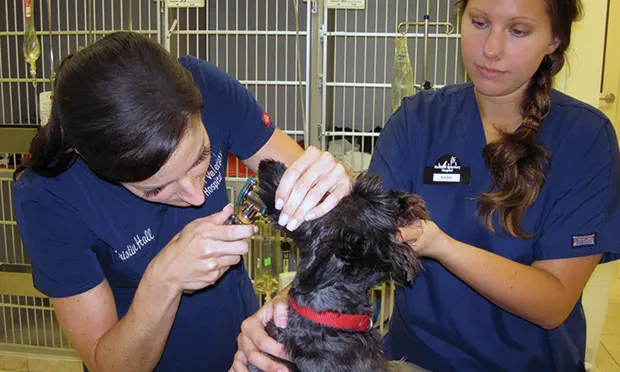Physical Examination: The Cornerstone of Veterinary Medicine
Douglas Mader, DVM, MS, DABVP (Canine & Feline Practice), DABVP (Reptile & Amphibian), DECZM (Herpetology), Marathon Veterinary Hospital, Marathon, Florida

For every clinical problem missed for not knowing, 10 will be missed for not looking. Physical examination (PE) is the cornerstone of diagnostic medicine—everything the clinician does for a patient is based on its results. If something small is missed during the PE, it can complicate later diagnostic problem solving.
Related Article: Attending to In-Clinic Patient Behavior: Where, When, How
Bad Medicine, Bad Business
After graduation, my first job boasted 6-minute appointments. If a patient came in for what the client reported to be a bad ear, that was all I was to examine—just the ears. My boss considered it a waste of time and resources to look at the rest of the patient. In addition, he felt it was good business to churn through the appointments, 10 per hour, rather than examining the entire animal.
In actuality, it was bad medicine not to look at the entire animal—what if the ear problem was related to allergies, foreign bodies, or metabolic issues? From a business perspective, if only the ears are examined, one may miss the heart murmur, dental disease, cataracts, and other, possibly more pressing, medical problems.
Important Considerations
Consistency must be a habit when it comes to PEs. By developing a consistent PE routine, the clinician is less likely to miss examining an area. The clinician should stick to a pattern when conducting the examination (eg, nose to tail, ears to feet). In cases in which the client brings a pet in for a specific complaint, the clinician–client relationship may benefit from focusing on the area of complaint before proceeding with a consistent, routine PE. The client may also benefit from an explanation that the presenting complaint may have roots elsewhere, emphasizing the necessity of the PE.
A PE can take on many forms and purposes (eg, annual, presurgical, health certificate, geriatric, insurance clearance, pre- or postpurchase examination). The clinician must decide how to approach these types of examinations and what services will be included or offered with them. For instance, for an annual examination on a young dog, the author is not likely to recommend an ECG unless the patient shows clinical signs (eg, heart murmur) or has a breed predilection to cardiac disease (eg, Cavalier King Charles). However, all senior pets (>8 years for small and medium breeds, >5 years for large and giant breeds) routinely get ECGs. Following are the steps this author considers essential to performing a thorough PE.
Clinical Skills You’ll Want to Keep
Get this guide in a free downloadable resource, along with guides to 5 more cornerstone skills you'll want to have in your back pocket. From choosing the correct fluid type to performing a neurological examination, Practical Guidance for New Veterinarians is your key to starting practice with confidence.
Before the Examination
First, the technician should obtain temperature, pulse, and respiratory rates. Blood pressure should be taken at the start of the examination, before the patient has a chance to become anxious and affect results. This can be done by the technician before the veterinarian arrives.
The history may be the most important part of any PE. It may be taken by the veterinary technician during check-in and should include (but not be limited to): Presenting complaint, patient age, spay/neuter status, vaccine history, ecto- or endoparasite preventive medications, issues with administration of prior or current medications, behavioral issues, health status of other household pets, and medical history. Querying owners several times during history taking—and using different wording—may yield more information about a patient’s relevant history. Clients often leave things out or do not think things are important the first time around.
The technicians should then record the date of when the presenting problem began, whether the problem is progressive or stable, and anything else deemed relevant by the client.
Step-by-Step: Physical Examination

STEP 1
Observe. Before handling the animal, evaluate its movement by watching it on the table or, if feasible, walking around the room. Vision can be evaluated by turning the lights down or off to watch the patient navigate in dim light, whereas hearing can be evaluated by calling to the patient or making a loud noise out of its line of sight.
Author Insight: For new pets, this author scans for a microchip at the beginning of the examination.
Closing Thoughts
Although some clients may prefer to avoid a thorough PE on their pet out of fear of problems being found, it is important that the veterinary team helps clients understand that finding problems early helps safeguard pets and ensure they receive proper care.
The author wishes to thank Kristin Hall, DVM; Kirsten Ebb, CVT; and Mike Stachowski for help in preparation of this article.